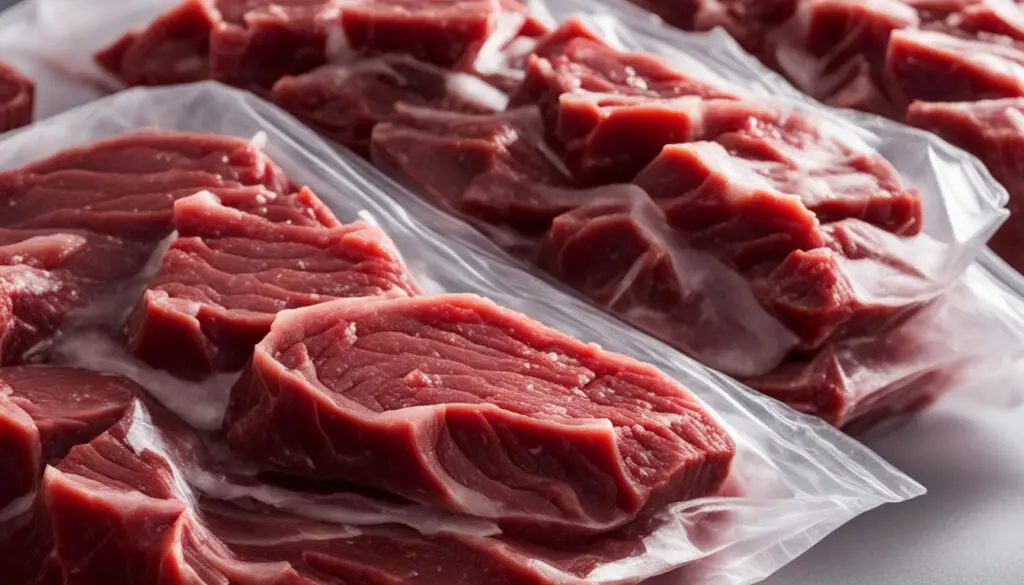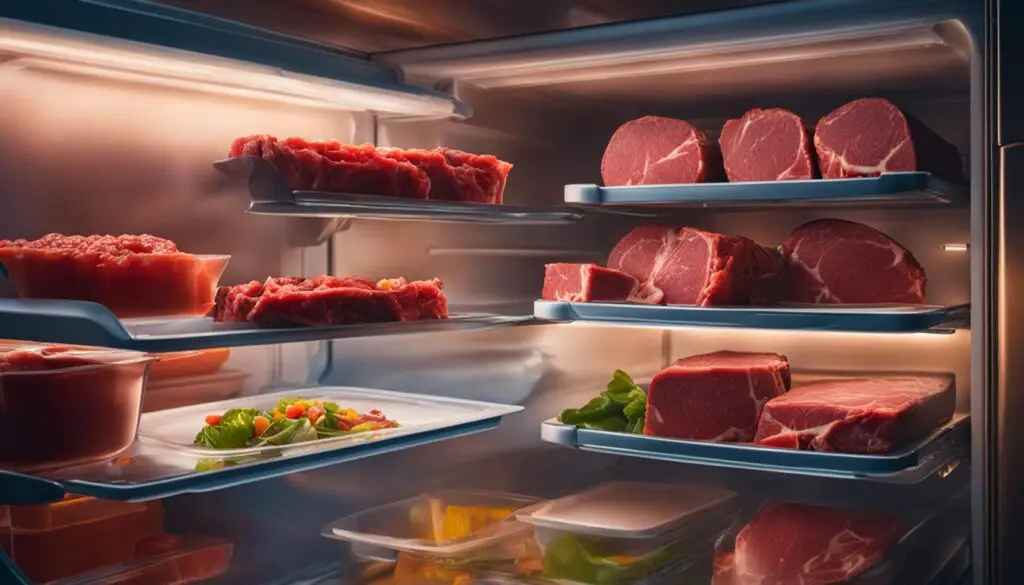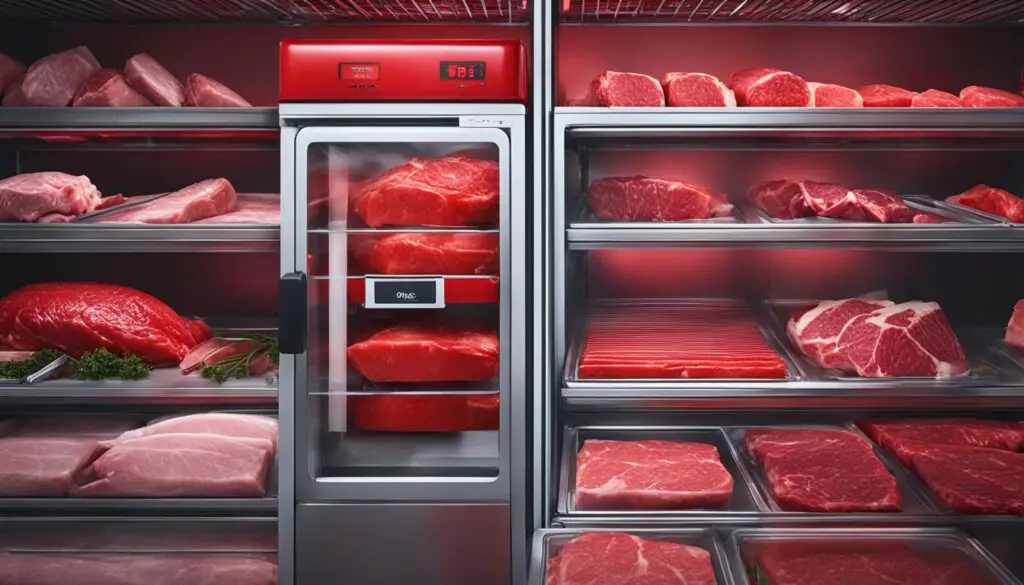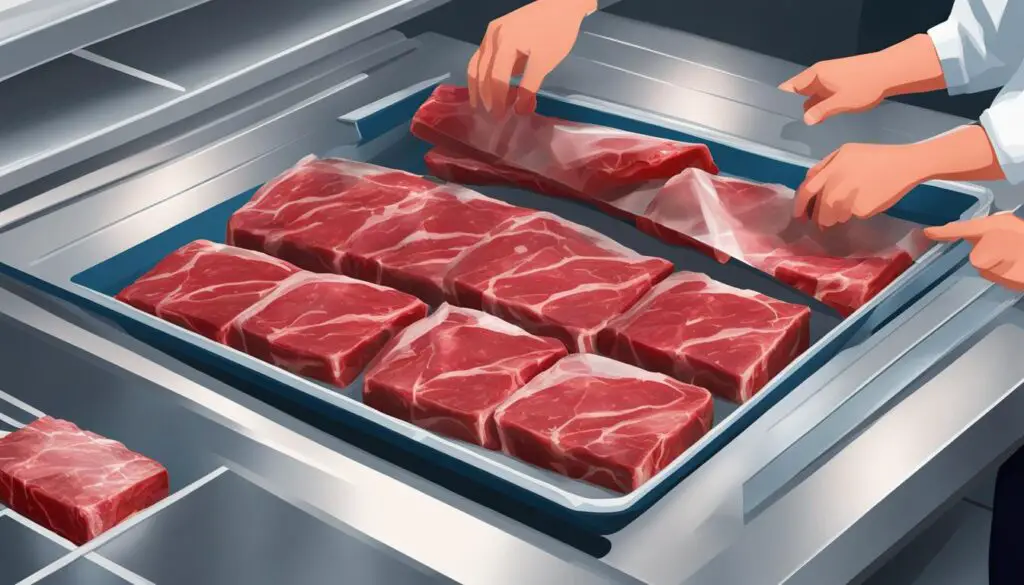Are you wondering how long you can safely store beef in your freezer? Whether you’re a meal prepper, a bulk buyer, or simply looking to extend the shelf life of your meat, understanding the freezing guidelines for beef is essential. In this guide, we’ll explore the recommended storage times for different cuts of beef, how freezing affects the quality of the meat, and provide you with helpful tips for successful beef freezing and thawing.
When it comes to freezing beef, it’s important to consider both safety and quality. While frozen beef will generally remain safe to eat indefinitely if stored at 0°F or lower, the taste and texture of the meat can deteriorate over time due to freezer burn. Freezer burn occurs when air comes into contact with the meat, resulting in dry and discolored spots.
So, how long can you store beef in the freezer? The recommended storage times for uncooked beef vary depending on the cut. Chops, steaks, and roasts can be stored for four to 12 months, while ground beef should be used within four months. Poultry, such as whole chicken or turkey, can last up to a year in the freezer.
To maintain the quality of the beef in the freezer, proper packaging is crucial. Minimizing air exposure is key to preventing freezer burn. Vacuum-sealing, using airtight plastic wrap, or transferring the meat to freezer bags can help protect it from air contact. Labeling the packages with the date of freezing will help you keep track of storage times.
When it’s time to thaw the frozen beef, it’s important to do so safely. Thawing in the refrigerator is the recommended method as it ensures a slow and steady thaw, minimizing the risk of bacterial growth. Alternatively, you can thaw the meat in cold water or use the microwave, following specific guidelines for each method.
Frozen beef can still taste delicious when properly stored and thawed. By understanding the recommended storage times, practicing proper packaging techniques, and using safe thawing methods, you can enjoy high-quality beef for an extended period.
Key Takeaways:
- Uncooked beef can be stored in the freezer for four to 12 months, depending on the cut.
- Proper packaging, such as vacuum-sealing or using airtight plastic wrap or freezer bags, helps prevent freezer burn.
- Thawing beef safely in the refrigerator, cold water, or the microwave ensures the meat remains safe and maintains its quality.
- Labeling the packages with the date of freezing helps keep track of storage times in the freezer.
- Properly stored and thawed beef can still taste delicious, even after being frozen.
How Does Freezing Affect Beef Quality?
When it comes to freezing beef, it’s important to consider the impact it has on the quality of the meat. While frozen beef can technically remain safe to eat indefinitely if stored at 0°F or lower, the texture and taste of the beef can deteriorate over time.
A common issue that can arise with frozen beef is freezer burn. Freezer burn occurs when air comes into contact with the surface of the meat, causing it to dehydrate. The result is a dry and leathery texture, which can significantly impact the overall eating experience.
To prevent freezer burn and preserve the quality of your beef, proper packaging is key. By minimizing air exposure, you can help maintain the moisture content and flavor of the meat. It is recommended to use airtight packaging such as vacuum-sealed bags or freezer-safe containers to create a barrier between the beef and the air.
In addition to proper packaging, the quality and longevity of the beef in the freezer can also be influenced by the level of processing. Minimally processed beef, such as uncooked cuts like chops, steaks, or roasts, tends to have better quality and taste retention compared to heavily processed beef.
If you notice any freezer-burned spots on your beef before or after cooking, it is advisable to cut them off. While lightly freezer-burned areas can be trimmed and enjoyed, heavily freezer-burned meat may need to be discarded.
Proper storage techniques, including appropriate packaging and labeling, are crucial for preserving the quality of beef in the freezer. By taking these steps, you can ensure that your frozen beef stays tasty and enjoyable until you’re ready to use it.
How Long Can Different Types of Beef Last in the Freezer?
When it comes to storing beef in the freezer, the recommended storage times can vary depending on the type of beef. According to the guidelines provided by the USDA, uncooked beef chops, steaks, or roasts can be safely frozen for a period of four to 12 months. On the other hand, uncooked ground beef has a shorter freezer lifespan of around four months.
It’s important to note that these storage times are general guidelines and can be influenced by factors such as the freshness of the meat at the time of freezing and the packaging used. To ensure that your beef stays fresh for longer in the freezer, it is recommended to properly wrap and label it before freezing.
While these guidelines can give you an idea of how long different types of beef can last in the freezer, it’s always a good idea to check the quality and appearance of the beef before consuming it, even if it falls within the recommended storage time. By following these beef freezing guidelines, you can ensure that your frozen beef remains safe and maintains its quality for an extended period.
| Type of Uncooked Beef | Storage Time in the Freezer |
|---|---|
| Chops, Steaks, or Roasts | 4 to 12 months |
| Ground Beef | Around 4 months |
Freezing Tips for Beef Storage
Properly packaging and storing beef in the freezer is crucial to maintain its quality and ensure it stays fresh. Here are some helpful tips to follow:
- Minimize air exposure: Air is the main culprit behind freezer burn. To prevent this, package the beef properly to minimize air contact. If the beef comes in a vacuum-sealed package, no additional wrapping is needed. If it is in a Styrofoam tray, over-wrap it tightly with plastic wrap or transfer it to a freezer bag.
- Squeeze out air: When packaging the beef, make sure to squeeze out as much air as possible from the packaging. This helps create a barrier against freezer burn and preserves the quality of the meat.
- Label and date the packages: To keep track of the storage times, it is advisable to label and date the packages. This way, you know when the beef was frozen and how long it has been stored.
- Freeze the beef flat: Lay the beef items flat in the freezer to freeze them as quickly as possible. Avoid stacking them until they are solid to prevent any deformation or damage to the meat.
- Minimize freezer door openings: Opening the freezer frequently can lead to temperature fluctuations, which can affect the quality of the frozen beef. If possible, use a stand-alone freezer or try to minimize the number of times you open the freezer door.
By following these freezing tips, you can ensure that your beef stays in optimal condition in the freezer, ready to be used whenever you need it.

Can Frozen Meat still Taste Good?
While frozen beef will technically remain safe to eat indefinitely if kept at 0°F or lower, the taste and quality of the meat can deteriorate over time. Freezer burn, which can occur due to air exposure, can affect the texture and taste of the beef, making it dry and leathery. However, if the meat is minimally freezer-burned, the affected spots can be cut off before or after cooking. It is important to assess the appearance and texture of the meat before consuming it, even if it falls within the recommended storage time.
The less processed the beef is, the longer its quality and taste will last in the freezer. Proper storage and handling techniques can help maintain the taste and quality of frozen beef.
Storing Other Types of Meat in the Freezer
In addition to beef, the freezer is also a great storage option for other types of meat. Whether it’s pork, poultry, or seafood, you can safely extend their shelf life by freezing them. Let’s take a closer look at the recommended storage times for different types of meat according to the USDA:
| Meat | Storage Time in the Freezer |
|---|---|
| Uncooked Pork (chops or roasts) | 4 to 6 months |
| Ground Pork | 3 to 4 months |
| Poultry (whole chicken or turkey) | Up to 1 year |
| Poultry (wings, breasts, or thighs) | 9 months |
| Giblets or Ground Chicken | 3 to 4 months |
| Frozen Raw Fish | 3 to 8 months |
| Shellfish (shrimp, scallops, mussels, oysters, clams) | 3 to 12 months |
It’s worth noting that these are general guidelines, and the quality of the meat or seafood should still be assessed before consuming. Storing meat properly in a freezer bag or airtight container will help maintain its quality and taste for longer periods. Labeling the packages with the date of freezing can also help keep track of storage times and ensure you use the meat within its recommended timeframe.
Freezing Tips for Other Types of Meat
In addition to beef, it’s important to properly freeze and store other types of meat to maintain their quality and taste. Whether you’re freezing pork, poultry, or seafood, following these tips will help ensure optimal results.
Freezing Pork
When freezing pork, it’s essential to minimize air exposure to prevent freezer burn. Just like with beef, you can follow the same guidelines. Properly package the pork by wrapping it tightly in plastic wrap or placing it in a freezer bag, squeezing out as much air as possible. Remember to label the packages with the date of freezing for easy reference.
Freezing Poultry
To freeze poultry, such as chicken or turkey, it’s best to remove excess air from the packaging. This can be done by using vacuum-sealed bags or tightly wrapping the bird in plastic wrap. Label the packages with the date of freezing to keep track of storage times and ensure proper rotation.
Freezing Seafood
When freezing seafood, it’s important to store it in airtight containers or bags to prevent air exposure. This will help maintain the quality and taste of the seafood. Additionally, never leave seafood out at room temperature for more than two hours to avoid the risk of bacterial growth.
By following these freezing tips for pork, poultry, and seafood, you can ensure that they stay fresh and delicious in the freezer until you’re ready to use them.

Recommended Freezing Times for Other Types of Meat
| Meat Type | Recommended Freezing Time |
|---|---|
| Pork chops or roasts | 4 to 6 months |
| Ground pork | 3 to 4 months |
| Whole chicken or turkey | Up to 1 year |
| Chicken or turkey parts (wings, breasts, thighs) | 9 months |
| Giblets or ground chicken | 3 to 4 months |
| Raw fish | 3 to 8 months |
| Shellfish (shrimp, scallops, mussels, oysters, clams) | 3 to 12 months |
Freezing Cooked Meat
In addition to freezing raw meat, cooked meat can also be frozen to extend its lifespan. The USDA provides guidelines for the recommended storage time of cooked meat in the freezer. It is important to note that the texture of raw frozen meat typically stays more pleasing compared to cooked frozen meat, as the cooking process can cause moisture loss.
According to the USDA, cooked poultry and fish should be consumed within four to six months of freezing. On the other hand, beef, veal, lamb, and pork should not be kept frozen for longer than two to three months.
Proper packaging, labeling, and handling techniques should be followed when freezing cooked meat to maintain its quality and taste.
Best Practices for Packaging Meat for Freezing
Proper packaging is essential for preserving the quality and integrity of meat in the freezer. The key is to minimize air exposure, as air can cause freezer burn and affect the taste and texture of the meat. Follow these best practices to ensure optimal packaging:
- If the meat comes in a vacuum-sealed package, it can be frozen as-is. The airtight seal of the packaging prevents air from reaching the meat, protecting it from freezer burn.
- If the meat is in a Styrofoam tray, it is recommended to over-wrap it tightly with plastic wrap or transfer it to a freezer bag. This extra layer of protection helps to minimize air contact and reduce the risk of freezer burn.
- Squeeze out as much air as possible from the packaging. Excess air can accelerate freezer burn, so make sure to remove as much air as you can before sealing the package.
- Consider using a vacuum sealer for longer-term storage. Vacuum sealers remove all the air from the packaging, creating an airtight seal that helps prevent freezer burn and extends the storage life of the meat.
- Label the packages with the date of freezing. This allows you to keep track of the storage time and ensures that you use the meat within the recommended storage period.
By following these packaging practices, you can prevent freezer burn and maintain the quality of the meat in the freezer, ensuring that it stays fresh and flavorful for longer.

Can Meat Be Refrozen After Thawing?
Have you ever wondered if it’s safe to refreeze meat after it has been thawed? The answer is, it depends on how you thawed the meat in the first place. According to the USDA, it is safe to refreeze raw meat if it was initially thawed in the refrigerator. However, keep in mind that there may be a slight loss in quality compared to fresh meat.
If you thawed the meat using the cold water or microwave methods, it is recommended to cook the entire portion before refreezing. Once the cooked meat has cooled or stopped steaming, you can safely freeze the leftovers. This method helps maintain the quality and safety of the meat.
It’s important to note that repeatedly freezing and thawing meat can result in moisture loss and potential changes in texture. Therefore, it is generally advised to only thaw and refreeze meat once to ensure the best quality.
Proper handling and storage both before and after thawing are crucial to maintaining the quality and safety of the meat.
| Method of Thawing | Recommended Approach |
|---|---|
| Refrigerator Thawing | Safe to refreeze |
| Cold Water Thawing | Cook the entire portion before refreezing |
| Microwave Thawing | Cook the entire portion before refreezing |
Note: It’s important to ensure that the meat is properly handled and stored to maintain its quality and safety.
Best Practices for Safely Thawing Frozen Meat
Thawing meat safely is crucial to prevent bacterial growth and maintain the quality of the meat. It’s important to avoid thawing meat on the kitchen counter or in hot water, as these methods can lead to rapid bacteria growth and compromise food safety.
The USDA recommends three safe methods for thawing frozen meat:
- Thawing in the refrigerator: This is the slowest but safest method. Small items may require overnight thawing, while large pieces of meat can take one day of thaw time for every five pounds.
- Thawing in cold water: This method is faster than refrigerator thawing. For 3-4 pound packages, it usually takes around two to three hours. Make sure to keep the meat in a leakproof plastic bag and change the water every 30 minutes to ensure it stays cold.
- Thawing in the microwave: This method should be done with caution as it can result in uneven thawing for larger pieces of meat and may start cooking small items. It is important to cook the meat immediately after thawing when using the microwave method.
By following these safe thawing methods, you can ensure that the meat is thawed properly and ready for cooking. Thawing meat in the refrigerator is the recommended method for achieving the best results in terms of food safety and maintaining the quality of the meat.

Freezer Tips for Economic Meat Storage
Keeping a well-stocked freezer can bring significant benefits, including cost savings and convenience. By taking advantage of bulk purchases and sale prices, you can save money in the long run. Additionally, having a variety of meat options readily available ensures a steady supply of protein for your meals.
Before heading to the grocery store or planning your meals, it’s a good idea to check what you already have in your freezer. This step helps you avoid unnecessary food waste and encourages you to use what you already have, reducing the need for additional purchases.
When it comes to buying meat, choosing suppliers that prioritize high animal care standards can provide peace of mind about the source and quality of the meat you consume. One such supplier is Coleman Natural Foods, known for their commitment to ethical and sustainable farming practices.
Proper management and organization of your stocked freezer is essential. Consider the following tips to maximize space and improve efficiency:
- Label your freezer bags or containers with the contents and date of freezing. Clear labeling allows easy identification of items, helps prevent food waste, and ensures you use the oldest items first.
- Rotate your stock regularly. Place newer items at the back of the freezer and move older items to the front. This practice ensures that you consume items before they exceed their recommended storage time.
- Investing in a standalone freezer can be beneficial if you have space and frequently purchase meat in bulk. The extra storage capacity allows you to take advantage of larger discounts and stock up on items.
- Consider creating an inventory list to keep track of what’s in your freezer. This practice helps you plan meals and prevents items from being forgotten or buried at the bottom.
A well-organized and well-stocked freezer gives you the flexibility to prepare a variety of meals while minimizing waste and saving money. By following these tips and making use of existing resources, you can enjoy the benefits of economic meat storage.
How Does Refrigeration Affect Meat Storage?
While the focus of this article is primarily on freezing meat, it is worth mentioning the importance of proper refrigeration when it comes to meat storage. Meat that is refrigerated should be kept below 40°F to ensure its safety and quality. Maintaining the correct temperature in your refrigerator is crucial in preventing bacterial growth and preserving the freshness of the meat.
When storing meat in the fridge, it is essential to adhere to the “use by” or “freeze by” dates provided on the packaging. Ground meat and poultry should be used within one to two days to ensure optimal quality. Steaks, chops, and roasts, on the other hand, can be refrigerated for three to four days before freezing to extend their storage time.
Properly organizing your refrigerator and maintaining a consistent temperature will help keep your meat fresh and safe for consumption. It is advisable to store raw meat on the lower shelves to prevent cross-contamination with other foods. Using airtight containers or resealable bags can further protect the meat from odors and potential contamination within the refrigerator.
Understanding the recommended storage times for different types of meat in the fridge is essential to ensure food safety. Following the FDA Food Storage Chart can provide more specific guidelines for refrigeration and freezer storage times for various types of meat, helping you make informed decisions about when to consume or freeze your meat.
Recap: How Long Should You Store Meat?
In summary, here is a recap of the recommended storage times for different types of meat in the freezer:
Uncooked Beef:
- Chops, Steaks, or Roasts: 4 to 12 months
- Ground Beef: 4 months
Pork:
- Chops: 4 to 6 months
- Roasts: Up to 1 year
Poultry:
- Whole Chickens or Turkeys: Up to 1 year
Seafood:
- Frozen Raw Fish: 3 to 8 months
- Shrimp, Scallops, Mussels, Oysters, Clams: 3 to 12 months
Cooked Meat:
- Beef, Veal, Lamb, Pork: Up to 2 to 6 months
- Poultry and Fish: 4 to 6 months
Remember to properly package the meat, label it, and follow storage techniques to ensure its freshness and quality throughout the recommended storage times.

Tips for Successful Meat Freezing and Thawing
To ensure the quality and safety of your meat during the freezing and thawing process, it’s important to follow proper techniques and best practices. By taking the right steps, you can minimize freezer burn and maintain the taste and texture of the meat.
Properly package the meat: When freezing meat, it’s crucial to minimize air exposure. Use vacuum sealers, plastic wrap, or freezer bags to achieve airtight packaging. This helps prevent freezer burn and preserve the quality of the meat. Consider labeling the packages with the date of freezing for easy tracking of storage times.
Thaw meat safely: When it’s time to thaw the meat, it’s essential to use safe methods to avoid bacterial growth. Thawing in the refrigerator is the slowest but safest method. If you need to thaw meat faster, you can use the cold water or microwave methods. However, avoid thawing on the counter or in hot water, as these methods can promote bacterial growth and compromise the safety of the meat.
By following these tips and best practices for meat freezing and thawing, you can ensure the quality and safety of your meat throughout the storage process. Proper packaging and safe thawing methods are key to preserving the taste and texture of the meat, allowing you to enjoy delicious meals every time.

Conclusion
Properly storing beef and other types of meat in the freezer is essential for maintaining their quality and taste. While frozen meat will technically remain safe to eat indefinitely when kept at 0°F or lower, freezer burn and deteriorating quality can affect the overall enjoyment of the meat.
To ensure the best results, it is important to follow freezing guidelines, properly package the meat to minimize air exposure, and label the packages for easy identification. By doing so, you can extend the storage time of your meat and preserve its taste and texture.
Thawing meat safely is equally important. Using safe thawing methods such as refrigerator thawing, cold water thawing, or microwave thawing can help prevent bacterial growth and maintain the quality of the meat.
By following best practices for meat storage, you can make the most of your freezer and enjoy delicious meat for an extended period of time. So remember, freeze with care and thaw with caution to savor the full potential of your meats.
FAQ
How long does beef last in the freezer?
According to the USDA, frozen beef can technically remain safe to eat indefinitely if kept at 0°F or lower. However, the quality and taste of the beef may deteriorate over time due to freezer burn.
How does freezing affect beef quality?
Freezing can cause freezer burn, which is identified by ice crystals on the surface of the meat or a shriveled and discolored appearance. This can affect the texture and taste of the beef, making it dry and leathery.
How long can different types of beef last in the freezer?
Uncooked beef chops, steaks, or roasts can be stored in the freezer for four to 12 months, while uncooked ground beef lasts around four months. These storage times are general guidelines and can vary based on factors such as the freshness of the meat at the time of freezing and the packaging used.
What are some freezing tips for beef storage?
Properly packaging the beef is crucial to minimize air exposure and prevent freezer burn. This can be done by over-wrapping Styrofoam tray meats in plastic wrap or transferring them to freezer bags. Squeezing out as much air as possible from the packaging and labeling the packages can also help preserve the quality of the beef.
Can frozen beef still taste good?
While frozen beef can technically remain safe to eat indefinitely, the taste and quality may diminish over time. The less processed the beef is, the longer its quality and taste will last in the freezer. Proper storage and handling techniques can also help maintain the taste and quality of frozen beef.
How should other types of meat be stored in the freezer?
Other types of meat, such as pork, poultry, and seafood, should be stored following similar guidelines as beef. Proper packaging, minimizing air exposure, and labeling the packages can help preserve the quality and taste of the meat in the freezer.
Can cooked meat be frozen?
Yes, cooked meat can be frozen. The recommended storage times for cooked meat vary depending on the type, with poultry and fish recommended to be consumed within four to six months, and beef, veal, lamb, and pork should not be kept frozen for longer than two to three months.
What are some best practices for packaging meat for freezing?
Properly packaging meat to prevent freezer burn involves minimizing air exposure. Vacuum sealers, plastic wrap, or freezer bags can be used to achieve airtight packaging, and labeling the packages with the date of freezing can help keep track of storage times.
Can meat be refrozen after thawing?
According to the USDA, raw meat can be refrozen if it was thawed in the refrigerator. However, there may be a slight loss in quality compared to fresh meat. If the meat was thawed using other methods, such as cold water or microwave, it is recommended to cook the entire portion and then freeze the cooked leftovers.
What are safe methods for thawing meat?
The USDA recommends three safe methods for thawing frozen meat: in the refrigerator, in cold water, or in the microwave. Thawing meat on the kitchen counter or in hot water is not recommended, as it can lead to rapid bacteria growth.
What are some tips for successful meat freezing and thawing?
Properly packaging the meat to minimize air exposure, following safe thawing methods, and using best practices for meat storage can help ensure the quality and safety of the meat throughout the freezing and thawing process.
How can a well-stocked freezer provide economic benefits?
A well-stocked freezer allows for bulk purchases and taking advantage of sale prices. Having a variety of meat options in the freezer ensures a steady supply of protein and can help save money in the long run.
How does refrigeration affect meat storage?
Meat that is refrigerated should be kept below 40°F to ensure its safety and quality. Ground meat and poultry should be used within one to two days, while steaks, chops, and roasts can be refrigerated for three to four days before freezing.
What are the guidelines for storing meat?
The recommended storage times for different types of meat vary. Proper packaging, labeling, and storage techniques should be followed to ensure meat stays fresh and maintains its quality throughout the recommended storage times.
What is the conclusion of the beef freezing guide?
The beef freezing guide provides guidelines on how long beef can last in the freezer, best practices for packaging and storing beef, and tips for successful freezing and thawing. Proper handling and storage techniques are essential to maintain the quality and taste of frozen beef.

